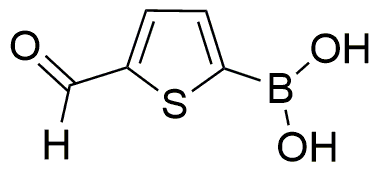5-Formyl-2-thiopheneboronic acid is widely utilized in research focused on:
- Organic Synthesis: This compound serves as a key building block in the synthesis of various organic molecules, particularly in the development of pharmaceuticals and agrochemicals.
- Drug Development: Its unique boronic acid functionality allows for the creation of biologically active compounds, making it valuable in medicinal chemistry for designing new drugs.
- Material Science: Used in the production of conductive polymers and organic electronics, it enhances the performance of materials in devices like solar cells and sensors.
- Catalysis: This compound acts as a catalyst in various chemical reactions, improving efficiency and selectivity in processes such as cross-coupling reactions.
- Bioconjugation: It is employed in bioconjugation techniques, allowing researchers to attach biomolecules to surfaces or other molecules, which is essential in diagnostics and therapeutic applications.
General Information
Properties
Safety and Regulations
Applications
5-Formyl-2-thiopheneboronic acid is widely utilized in research focused on:
- Organic Synthesis: This compound serves as a key building block in the synthesis of various organic molecules, particularly in the development of pharmaceuticals and agrochemicals.
- Drug Development: Its unique boronic acid functionality allows for the creation of biologically active compounds, making it valuable in medicinal chemistry for designing new drugs.
- Material Science: Used in the production of conductive polymers and organic electronics, it enhances the performance of materials in devices like solar cells and sensors.
- Catalysis: This compound acts as a catalyst in various chemical reactions, improving efficiency and selectivity in processes such as cross-coupling reactions.
- Bioconjugation: It is employed in bioconjugation techniques, allowing researchers to attach biomolecules to surfaces or other molecules, which is essential in diagnostics and therapeutic applications.
Documents
Safety Data Sheets (SDS)
The SDS provides comprehensive safety information on handling, storage, and disposal of the product.
Product Specification (PS)
The PS provides a comprehensive breakdown of the product’s properties, including chemical composition, physical state, purity, and storage requirements. It also details acceptable quality ranges and the product's intended applications.
Certificates of Analysis (COA)
Search for Certificates of Analysis (COA) by entering the products Lot Number. Lot and Batch Numbers can be found on a product’s label following the words ‘Lot’ or ‘Batch’.
Número de catálogo
Número de lote/lote
Certificates Of Origin (COO)
This COO confirms the country where the product was manufactured, and also details the materials and components used in it and whether it is derived from natural, synthetic, or other specific sources. This certificate may be required for customs, trade, and regulatory compliance.
Número de catálogo
Número de lote/lote
Safety Data Sheets (SDS)
The SDS provides comprehensive safety information on handling, storage, and disposal of the product.
DownloadProduct Specification (PS)
The PS provides a comprehensive breakdown of the product’s properties, including chemical composition, physical state, purity, and storage requirements. It also details acceptable quality ranges and the product's intended applications.
DownloadCertificates of Analysis (COA)
Search for Certificates of Analysis (COA) by entering the products Lot Number. Lot and Batch Numbers can be found on a product’s label following the words ‘Lot’ or ‘Batch’.
Número de catálogo
Número de lote/lote
Certificates Of Origin (COO)
This COO confirms the country where the product was manufactured, and also details the materials and components used in it and whether it is derived from natural, synthetic, or other specific sources. This certificate may be required for customs, trade, and regulatory compliance.


